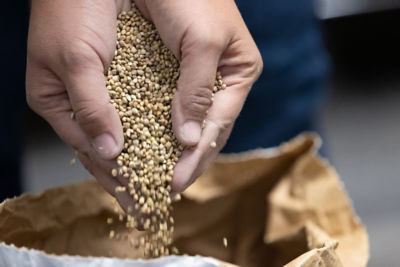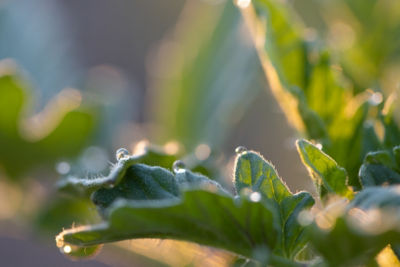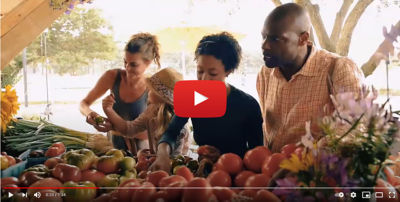Click here to download a PDF version of this spotlight.
» Market requirements and seasonality determine the types of peppers to grow.
» Tolerance of temperature extremes and adaptability to local conditions impact variety selection.
» Resistance to locally important diseases can be critical to production success.
While yield potential is usually the primary characteristic of concern for growers selecting bell pepper varieties, a number of other factors should also be considered as they can impact marketable yields or other aspects of production that determine the profitability of an operation.
 Figure 1. Medium sized fruit can be preferred by processors and some large scale retailers, while large fruit may be desired for specialty retail markets.
Figure 1. Medium sized fruit can be preferred by processors and some large scale retailers, while large fruit may be desired for specialty retail markets.
Yield Potential, Planting Slots, and Regional Adaptability
Yield potential, measured as the number or weight of fruit per acre, is certainly a characteristic that growers are interested in when selecting pepper varieties. However, estimated yield potential alone is not always the best predictor of how successful a variety will be for an operation. The timing, number, and size of plantings during a season should be synchronized with the needs of the market. Planting schedules vary with geographic region as well as the intended market [processing, fresh market, large retail, specialty retail, farmers markets, community supported agriculture (CSA), etc.].1
Time of production during the season (planting slot) is also affected by the relative maturity (earliness) of the variety. Early maturing varieties can be used to help capture the early season market in some areas. However, a variety’s response to local conditions, including temperature, rainfall, sunlight, and soil type, will also affect the timing and quality of fruit production. A variety that performs well in one location or during one time of the season may perform very differently at different locations and times.2,3 For example, a variety can exhibit good cold tolerance, growing and setting fruit well early in the spring, but may not do well in the heat of the summer because of problems with sunburn, low fruit set, or undesirable fruit shape. Pollination of pepper fruit is affected by temperature (both high and low), and low seed set due to poor pollination can affect fruit shape and development.4,5 Growers should be cautious about choosing varieties that may mature early at the expense of other desirable characteristics, such as proper fruit shape.
Flowering Patterns and Plant Height
Many commercial growers, especially those selling to processors or the large retail market, wish to limit the number of harvests to two or three per planting, with 30 to 40% of the fruit picked during the first harvest. This requires varieties that have concentrated periods of flowering and fruit production. Other growers, selling at farmers markets or supplying restaurants, may prefer varieties with a more continuous pattern of flowering, which results in multiple harvests over a longer period of time.
Pepper varieties also differ in plant height, which affects production in a number of ways. In general, taller plants yield more, but tall plants can have more problems with lodging and require staking in some production systems or regions. Also, some growers using a staked plant system have adapted their systems to moderately sized plants, and switching to a variety with a larger plant size would mean needing to purchase longer stakes and, perhaps, altering plant spacing. There is also a tendency for shorter plants to have a concentrated pattern of flowering, while taller plants tend to have a more continuous flowering pattern. So growers may prefer shorter plants for a number of reasons.
Fruit Size and Quality
In addition to yield and flowering pattern, the other primary characteristics considered when selecting varieties are fruit size and quality. Marketable fruit are sorted into the size categories medium, large, extra large, jumbo, and super jumbo. You might think that bigger is always better, but that is not the case with peppers. The desired fruit size will depend on the intended market. Medium sized fruit are often preferred by processors producing “cups” and by large scale retailers, where fruit are sold by the piece (Figure 1). Larger fruit may be preferred by processors producing chopped peppers, or by specialty retailers or for farmer’s markets where fruit are sold by weight.
Fruit shape is important in determining marketability. The standard shape for green bell peppers is a blocky, four lobed fruit with a width to length ratio from 1:1 to 1:1.2, depending on the region. The number of lobes can affect shape, with four lobed fruit usually having a more blocky, less pointed shape than fruit with fewer lobes (Figure 2).
 Figure 2. The length of fruit can be affected by temperatures during fruit development. Also, the three lobed fruit on the right is more pointed than the blocky, four lobed peppers to the left.
Figure 2. The length of fruit can be affected by temperatures during fruit development. Also, the three lobed fruit on the right is more pointed than the blocky, four lobed peppers to the left.
Fruit shape can be affected by temperature, with longer fruit forming during periods of higher temperatures. This is one way in which seasonality affects fruit production. A variety that produces a blocky fruit when temperatures are cooler may produce a fruit that is too long during warmer conditions, while a variety that produces a proper shaped fruit under warm conditions may produce fruit that is too short when temperatures are cooler (Figure 2).6,7 However, some varieties are very stable and maintain a consistent fruit shape over a wide range of temperature conditions.
The color of the fruit is also important. For green bell peppers, a dark green color is preferred, but it is more important to have fruit with uniform, non-blotchy color. A lighter green, uniform colored fruit is generally more desirable than a darker but blotchy fruit. In addition, the formation of dark purple pigmentation, a condition called “blue nose”, can render the fruit unmarketable. This problem can be avoided by using Anthocyaninless varieties.
Disease Resistance
The disease resistance traits of a variety need to be considered, as diseases can dramatically impact production. One of the most common and damaging pepper diseases is bacterial spot, which causes brown spots on leaves and fruit, and can result in significant defoliation. There are many races of the pathogen that causes this disease. Therefore, it is important to select varieties that have resistance genes that are effective against the races present, especially in areas with regular rainfall or in fields receiving overhead irrigation, conditions that favor disease development.3
Phytophthora blight, caused by a fungal-like organism, can be prevalent and cause significant losses in locations with high soil moistures, such as low areas of a field. Varieties with resistance to the crown and root rot phases of Phytophthora blight are very useful in these situations.8,9
Peppers are also susceptible to a number of viral pathogens, including Tomato spotted wilt virus (TSWV), Tobacco etch virus (TEV), Cucumber mosaic virus (CMV), Tobacco mosaic virus (TMV), Potato virus Y (PVY), and others. There are several races of some viruses, such as PVY, and it is important to select varieties that are resistant to the races present in the growing area.8,9
Two abiotic disorders that affect peppers are blossom end rot and silvering. With blossom end rot, the blossom end of the fruit turns brown and dies. This condition is associated with moisture stress and uneven soil moisture levels.10 Silvering occurs when the epidermal layer of the fruit separates from the tissues below. There has been some association of this condition with environmental stress and high fertility rates, but some studies show that it is primarily determined by the genetics of the plant.11 Susceptibility to both of these disorders varies among varieties, and selecting varieties that are less prone to these problems can be beneficial.
Sources
1 Orzolek, M. D., Kime, L. F., Bogash, S. M., Harper, J. K., and Harsh, R. M. 2010. Agricultural alternatives: Pepper production. Penn State Extension. http://extension.psu.edu/business/ag-alternatives/horticulture/vegetables/pepper-production.
2 Portree, J. 1996. Greenhouse vegetable production guide for commercial growers. Province of British Columbia Ministry of Agriculture, Fisheries and Food.
3 University of Georgia, Cooperative Extension. 2009. Commercial pepper production handbook. Bulletin 1309.
4 Erickson, A. N. and Markhart, A. H. 2001. Flower production, fruit set, and physiology of bell pepper during elevated temperature and vapor pressure deficit. J. Amer. Soc. Hort. Sci. 126(6):697–702.
5 Pressman, E., H. Moshkovitch, K. Rosenfeld, R. Shaked, B. Gamliel and B. Aloni. 1998. Influence of low night temperatures on sweet pepper flower quality and the effect of repeated pollinations, with viable pollen, on fruit setting. Journal of Horticultural Science & Biotechnology 73(1)131-136.
6 Deli, Y., Tiessen, H., 1969. Interaction of temperature and light intensity on flowering of Capsicum frutescens var. grossum cv. California Wonder. J. Am. Soc. Hort. Sci. 94, 349-351.
7 Pressman, E., Moshkovitch, H., Rosenfeld, K., Shaked, R., Gamliel, B., and Aloni, B. 1998. Influence of low night temperatures on sweet pepper flower quality and the effect of repeated pollinations, with viable pollen, on fruit setting. Journal of Horticultural Science & Biotechnology 73(1)131-136.
8 Engel, D. et al. 2016. Midwest vegetable production guide for commercial growers.
9 Reiners, S. et al. 2016. Cornell integrated crop and pest management guidelines for commercial vegetable production.
10 Saure, M. C. 2014. Why calcium deficiency is not the cause of blossom-end rot in tomato and pepper fruit – a reappraisal. Scientia Horticulturae 174 : 151-154. 11 Kline, W. L., Wyenandt, C. A., Ward, D. L., Sudal, J. F., and Maxwell, N. L. 2011. Evaluation of six nitrogen fertility programs on marketable yield and development of skin separation in bell pepper fruit. HortTechnology 21:323–328. Websites verified 1/29/16.
Additional Information
For additional agronomic information, please contact your local seed representative.Developed in partnership with Technology, Development & Agronomy by Monsanto.
Individual results may vary, and performance may vary from location to location and from year to year. The information provided in this article may not be an indicator of results you may obtain as local growing, soil and weather conditions may vary. Growers should evaluate data from multiple locations and years whenever possible. The recommendations in this article are based upon information obtained from the cited sources and should be used as a quick reference for information about growing peppers. The content of this article should not be substituted for the professional opinion of a producer, grower, agronomist, pathologist and similar professional dealing with this specific crop.
SEMINIS DOES NOT WARRANT THE ACCURACY OF ANY INFORMATION OR TECHNICAL ADVICE PROVIDED HEREIN AND DISCLAIMS ALL LIABILITY FOR ANY CLAIM INVOLVING SUCH INFORMATION OR ADVICE. 160118104920 021216DME
Seminis® is a registered trademark of Seminis Vegetable Seeds, Inc. © 2016 Seminis Vegetable Seeds, Inc.



